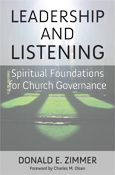You may share the sentiment captured in Barnett Cock’s remark, “A committee is a cul-de-sc down which ideas are lured and then quietly strangled.” This somewhat humorous, tongue-in-cheek analogy may have more than a grain of truth for members of many church councils, ministry teams, task forces, committees, and organizations. If you want a good idea to die or a creative action plan to be stillborn, then just give it to a committee, say sarcastic naysayers. Why do people put down, scorn, or speak critically about these pervasive, established, and, at times, effective staples in most churches?
Perhaps negative impressions of committee meetings have less to do with inherent weaknesses or failures of group work per se than they do with dysfunctional group practices and behaviors. Here are eight simple guidelines that can go a long way to help people be more effective in how they lead meetings.
1. How we view ourselves as group leaders matters.
While leadership may emerge naturally, most church groups have a leader. Someone is usually designated to help the group accomplish its task and work as a team. Here’s how I view myself as a group leader: I am a member of the group designated to help the group go where it wants to go to the extent that such help is needed.
2. People enter a group with two primary questions: Why are we here? And how may I participate?
Put clarity of group purpose and member participation at the top of your “to do” list early in group life. Most people want to know why they are meeting, and how they may participate. Create an overview of your group’s objectives, goals, purposes, and processes. Likewise, develop conversation guidelines that let members know what is expected of them as participants.
3. Groups usually need a balance of task-work and teamwork.
Some people’s primary interest is the accomplishment of their group’s task. Other people are most interested in working together as a team. In reality, both task-work and teamwork are important. So, what’s needed is a balanced approach. While this understanding will seem intuitive to most people, nonetheless, patience with one another is often required. In most instances, both group productivity and group cohesion are achievable expectations.
4. Groups need leaders who are flexible and adaptable.
In recent years, a new theory of leadership effectiveness has evolved: a flexible, adaptable approach. Rather than posses certain traits, develop certain styles, or focus on certain situational factors, here, it’s the behavior of leaders that matter. Specifically, we can help our leaders increase their behavioral flexibility so they can adapt to such situational factors as group structure, leader power, and leader-member relations.
Sometimes, there will be a greater demand for task-oriented behaviors. And other times, a greater emphasis on relationship-oriented behaviors is required. What we need are leaders who’ve learned how both to jettison ineffective leadership behaviors and to practice effective leadership behaviors.
5. Groups must learn how to deal with dysfunctional member behavior.
Most groups will experience periodic difficulties in the way members interact with one another. Here are some common group problems you may encounter: aggressiveness, anxiety, avoidance of depth, backstabbing, cultural Insensitivity, defensiveness, disgruntlement or agitation, distrust, domination, fearfulness, inappropriate settings, inflexibility, judging, passivity, stubbornness, superficiality, and unfilled expectations.
While a daunting challenge, it is generally best to face dysfunctional behavior openly, directly, and creatively. Perhaps the best way for a group to deal directly with dysfunctional behavior is to build into group life regular periods of review. Have people name specific troublesome behaviors, describe how they experience such behavior, and then offer suggestions for changing the dysfunctional behavior.
6. Groups function properly when everyone contributes.
Active participation of all small group members is imperative for healthy group discussion and quality decision-making. It’s okay that some people are talkative while others are quiet. What’s not okay is when people so dominate group discussion that opportunity for everyone to speak is sacrificed. Conversely, what isn’t okay is when people so withhold their contribution to group discussion and decision-making that valuable insight is forfeited.
Here are seven strategies for achieving full-group participation: round-robin sharing, breakout groups, open space meetings, Eric Law’s Mutual Invitation, Roberts Rules of Order, process observation, and cultivating curiosity.
7. Groups can profit from collaborative decision-making.
Most groups have topics to explore, discussion to engage, problems to solve, and decisions to make. Normally, these activities require collaboration between leaders and member. For example, ownership and implementation of group decisions often require mutually agreeable decision-making. Traditional bureaucratic patterns of organizing and leadership often are hard-pressed to deliver these desired results.
In our post-modern, post-Christian, post-denominational era, there seems to be a greater receptivity, renewal, and practice of collaborative leadership than in previous generations. Nonetheless, the top-down, corporate model of directed leadership remains commonplace in many quarters. While some may resist this movement from bureaucratic to collaborative leadership, this shift will be particularly beneficial for leading meetings in churches.
8. A very simple agenda can lead to lively group discussion.
I facilitate an adult education class. Often we view a 15-20 minute video presentation, then have 30-40 minutes of group discussion. Two factors are largely responsible for creating lively conversation: compelling content, and simple group direction. In fact, stimulating content seems to produce lively group discussion. Whereas most video resources provide questions for group discussion, I find that this simple, single question almost always results in lively, stimulating, productive group discussion: “what strikes you in the video?” I merely invite reflections, and then moderate the sharing of reactions to the video and to one another’s contributions. In short, I help us help each other learn. This experience is a classic demonstration of the adage the process is the product.
This article is adapted and excerpted from the Congregations magazine article, “Another Committee? You Must Be Crazy! – 8 Guidelines for Leading Meetings.”
Copyright © 2013, the Alban Institute. All rights reserved. We encourage you to share Alban Weekly articles with your congregation. We gladly allow permission to reprint articles from the Alban Weekly for one-time use by congregations and their leaders when the material is offered free of charge. All we ask is that you write to us at alban@div.duke.edu and let us know how Alban Weekly is making an impact in your congregation. If you would like to use any other Alban material, or if your intended use of Alban Weekly does not fall within this scope, please submit our reprint permission request form.

Small Groups in the Church: A Handbook for Creating Community
Thomas G. Kirkpatrick
This planning and leader training handbook offers a distinctive broad-based, small-group approach to building community. From the Jewish havurot to Christian koinonia, you will gain a thorough understanding of community, learn how to plan an effective small-group ministry, how to select and train leaders for all kinds of small groups, and how to start small groups that are a part of and not apart from their congregations. Appendices provide an overview of the sociological, psychological, and biblical theological literature on community and a wealth of presentation and leader training resources.

Know and Be Known: Small Groups That Nourish and Connect
Brooke B. Collison
People yearn for a sense of belonging. Congregations become places of belonging when people find ways to make connections, form relationships, and share their personal stories. That’s hard to do in the hasty comings and goings around the typical worship service. It’s even hard to do in a choir, committee, or ministry group.In Know and Be Known, Brooke Collison looks at the element missing in most group dynamics today: intentionality about relationships. Counselor, educator, and long-time leader and participant in small groups, Collison knows the power of small groups to create meaningful bonds of friendship and support.
 Reflecting with God: Connecting Faith and Daily Life in Small Groups
Reflecting with God: Connecting Faith and Daily Life in Small Groups
Abigail Johnson
Untangling the day-to-day issues in our multifaceted lives can seem daunting. Time to sit quietly and reflect is rare. If we are fortunate, we have good friends or close family members with whom to talk things through and find clarity, but many times we feel isolated and lonely. As people of faith, we add another layer to our reflections when we wonder where God fits into our lives.
 Leadership and Listening: Spiritual Foundations for Church Governance
Leadership and Listening: Spiritual Foundations for Church Governance
Donald E. Zimmer
Church leaders must fundamentally change the way they view leadership, governance, and management in their organizations if they are to take seriously the need to listen to God’s desires before acting. In Leadership and Listening, readers will find encouragement and specific suggestions for re-imagining church governance and management.
Alignment: Get Your Congregation’s Systems Working Together!
Leader: John Wimberly, Alban Consultant and Author
Location: Epworth-by-the-Sea, St. Simon’s Island, GA
Date: February 4 – 6, 2013 – Part of an Alban Cluster of Learning Events
Celebrate Alban’s 40th Anniversary

Register for any 2014 Alban event
before December 31, 2013 and save $40.
